Interaction between Thermal Conditions and Ventilation in Kindergartens in Melbourne, Australia
Abstract
1. Introduction
2. Materials and Methods
2.1. Kindergarten Selection
2.2. Data Collection
2.3. Data Consolidation and Analysis
3. Results and Discussions
3.1. IAQ and Ventilation
3.2. Thermal Comfort
3.3. Ventilation and Thermal Comfort Correlational Analysis
4. Conclusions
Author Contributions
Funding
Institutional Review Board Statement
Informed Consent Statement
Data Availability Statement
Conflicts of Interest
Appendix A. Monitoring Equipment Accuracy
| Device | Reading | Accuracy | Source |
|---|---|---|---|
| Testo 480 IAQ probe | Air temperature | ±0.5 °C | Testo SE and Co (2022) [45] |
| Testo 480 IAQ probe | Humidity | ±(1.8% RH + 0.7% of mv) | Testo SE and Co (2022) [45] |
| Testo 480 IAQ probe | CO2 | ±(75 ppm + 3% of mv) 0 to +5000 ppm | Testo SE and Co (2022) [45] |
| Testo 480 globe thermometer | MRT | Class 1 | Testo SE and Co (2022) [46] |
| Testo 480 comfort level probe | Velocity | ±(0.03 m/s + 4% of mv) | Testo SE and Co (2022) [47] |
| HOBO MX1102 | Temperature | ±0.21 °C from 0° to 50 °C | Onset Computer Corporation (2015) [48] |
| HOBO MX1102 | Humidity | Maximum of ±4.5% at 25 °C | Onset Computer Corporation (2015) [48] |
| HOBO MX1102 | CO2 | ±50 ppm ±5% of reading at 25 °C, less than 70% RH and 1013 mbar | Onset Computer Corporation (2015) [48] |
| HOBO U12-013 | Temperature | ±0.35 °C from 0° to 50 °C | Onset Computer Corporation (2016) [49] |
| HOBO U12-013 | Humidity | Maximum of ±3.5% from 10% to 90% RH | Onset Computer Corporation (2016) [49] |
References
- Andamon, M.M.; Woo, J. Indoor environmental quality of preparatory to year 12 (P-12) educational facilities in Australia: Challenges and prospects. In Energy Performance in the Australian Built Environment; Rajagopalan, P., Andamon, M.M., Moore, T., Eds.; Springer Nature: Singapore, 2019; pp. 111–130. ISBN 978-981-10-7880-4. [Google Scholar]
- AS 1668.4; The Use of Ventilation and Airconditioning in Buildings—Part 4 Natural Ventilation in Buildings. SAI Global Database: Sydney, Australia, 2012.
- Haddad, S.; Synnefa, A.; Marcos, M.A.P.; Paolini, R.; Delrue, S.; Prasad, D.; Santamouris, M. On the potential of demand-controlled ventilation system to enhance indoor air quality and thermal condition in Australian school classrooms. Energy Build. 2021, 238, 110838. [Google Scholar] [CrossRef]
- Rajagopalan, P.; Andamon, M.M.; Woo, J. Year long monitoring of indoor air quality and ventilation in school classrooms in Victoria, Australia. Archit. Sci. Rev. 2022, 65, 1–13. [Google Scholar] [CrossRef]
- Snow, S.; Danam, R.; Leardini, P.; Glencross, M.; Beeson, B.; Ottenhaus, L.-M.; Boden, M. Human factors affecting ventilation in Australian classrooms during the COVID-19 pandemic: Towards insourcing occupants’ proficiency in ventilation management. Front. Comput. Sci. 2022, 4, 888688. [Google Scholar] [CrossRef]
- Cosbod, E.; Annesi-Maesano, I.; Carrer, P.; Kephalopoulos, S.; Madureira, J.; Rudnai, P.; de Oliveira Fernandes, E.; Barrero, J.; Beregszászi, T.; Hyvärinen, A.; et al. Final Report: Schools Indoor Pollution and Health Observatory Network in Europe (SINPHONIE), JRC Publications Repository Website. 2014. Available online: https://publications.jrc.ec.europa.eu/repository/handle/JRC91160 (accessed on 14 April 2022).
- Borgese, L.; Tomasoni, G.; Marciano, F.; Zacco, A.; Bilo, F.; Stefana, E.; Cocca, P.; Rossi, D.; Cirelli, P.; Ciribini, A.L.C.; et al. Definition of an Indoor Air Sampling Strategy for SARS-CoV-2 Detection and Risk Management: Case Study in Kindergartens. Int. J. Environ. Res. Public Health 2022, 19, 7406. [Google Scholar] [CrossRef]
- Muhic, S.; Muhic, T. Measurements of air quality in kindergartens and schools in the Republic of Slovenia before the COVID-19 Epidemic. Stroj. Vestn.-J. Mech. Eng. 2022, 68, 290–299. [Google Scholar] [CrossRef]
- Persily, A. Development and application of an indoor carbon dioxide metric. Indoor Air 2022, 32, e13059. [Google Scholar] [CrossRef] [PubMed]
- Shendell, D.G.; Prill, R.; Fisk, W.J.; Apte, M.G.; Blake, D.; Fawkner, D. Associations Between Classroom CO2 Concentrations and Student Attendance in Washington and Idaho. Indoor Air 2004, 14, 333–341. [Google Scholar] [CrossRef] [PubMed]
- Wargocki, P.; Porras-Salazar, J.A.; Contreras-Espinoza, S.; Bahnfleth, W. The relationships between classroom air quality and children’s performance in school. Build. Environ. 2020, 173, 106749. [Google Scholar] [CrossRef]
- Woo, J.; Rajagopalan, P.; Andamon, M.M. An evaluation of measured indoor conditions and student performance using d2 Test of Attention. Build. Environ. 2022, 214, 108940. [Google Scholar] [CrossRef]
- Simoni, M.; Annesi-Maesano, I.; Sigsgaard, T.; Norback, D.; Wieslander, G.; Nystad, W.; Canciani, M.; Sestini, P.; Viegi, G. School air quality related to dry cough rhinitis and nasal patency in children. Eur. Respir. J. 2010, 35, 742–749. [Google Scholar] [CrossRef] [PubMed]
- Sadrizadeh, S.; Yao, R.; Yuan, F.; Awbi, H.; Bahnfleth, W.; Bi, Y.; Cao, G.; Croitoru, C.; de Dear, R.; Haghighat, F.; et al. Indoor air quality and health in schools: A critical review for developing the roadmap for the future school environment. J. Build. Eng. 2022, 57, 104908. [Google Scholar] [CrossRef]
- D6245-18; Standard Guide for Using Indoor Carbon Dioxide Concentrations to Evaluate Indoor Air Quality and Ventilation. ASTM International: West Conshohocken, PA, USA, 2018.
- Gładyszewska-Fiedoruk, K. Correlations of air humidity and carbon dioxide concentration in the kindergarten. Energy Build. 2013, 62, 45–50. [Google Scholar] [CrossRef]
- Mijakowski, M.; Sowa, J. An attempt to improve indoor environment by installing humidity sensitive air inlets in a naturally ventilated kindergarten building. Build. Environ. 2016, 111, 180–191. [Google Scholar] [CrossRef]
- Dovjak, M.; Slobodnik, J.; Krainer, A. Consequences of Energy Renovation on Indoor Air Quality in Kindergartens. Build. Simul. 2020, 13, 691–708. [Google Scholar] [CrossRef]
- Lovec, V.; Premrov, M.; Leskovar, V.Z. Practical impact of the COVID-19 pandemic on indoor air quality and thermal comfort in kindergartens. A case study of Slovenia. Int. J. Environ. Res. Public Health 2021, 18, 9712. [Google Scholar] [CrossRef]
- Hammad, M.; Ebaid, M.S.Y.; Al-Hyari, L. Green building design solution for a kindergarten in Amman. Energy Build. 2014, 76, 524–537. [Google Scholar] [CrossRef]
- Li, Y.; Qian, H.; Hang, J.; Chen, X.; Cheng, P.; Ling, H.; Wang, S.; Liang, P.; Li, J.; Xiao, S.; et al. Probable Airborne Transmission of SARS-CoV-2 in a Poorly Ventilated Restaurant. Build. Environ. 2021, 196, 107788. [Google Scholar] [CrossRef] [PubMed]
- CDC (Centres for Disease Control and Prevention). Ventilation in Buildings Frequently Asked Questions. Available online: https://www.cdc.gov/coronavirus/2019-ncov/community/ventilation.html#Ventilation-FAQs (accessed on 20 November 2022).
- Crabb, B.; Doolan, C.; Cole, K.; Hanmer, G.; Marks, G.; Miller, A.; Monty, J.; Morawska, L.; de Silva, C. OzSage Safe Indoor Air (Ventilation) Recommendations. Available online: https://ozsage.org/wp-content/uploads/2021/09/Safe-Indoor-Air-advice.pdf (accessed on 19 September 2022).
- Schofield, R. University of Melbourne Guide to Air Cleaner Purchasing. Available online: https://sgeas.unimelb.edu.au/engage/guide-to-air-cleaner-purchasing (accessed on 14 April 2022).
- Department of Education and Training, Commonwealth. The Early Years Learning Framework for Australia. Available online: https://www.acecqa.gov.au/sites/default/files/2018-02/belonging_being_and_becoming_the_early_years_learning_framework_for_australia.pdf (accessed on 18 April 2022).
- Department of Education and Training, Victoria. All about Kindergarten. Available online: https://www.education.vic.gov.au/Documents/childhood/parents/kindergarten/allaboutkinder.pdf (accessed on 14 April 2022).
- Hassan, J. The Washington Post: With Winter on the Way and Windows Open, Europe’s Students Prepare for the Cold. Available online: https://www.washingtonpost.com/world/2020/10/13/school-windows-coronavirus-europe-winter/ (accessed on 20 November 2022).
- CDC (Centres for Disease Control and Prevention). Ventilation in Buildings. Available online: https://www.cdc.gov/coronavirus/2019-ncov/community/ventilation.html (accessed on 20 November 2022).
- Department of Education and Training, Victoria. Ventilation Advice for Early Childhood Education and Care Services. Available online: https://www.education.vic.gov.au/Documents/about/department/covid-19/ecec/ventilation-advice.pdf (accessed on 15 April 2022).
- Wyon, D.P. Studies of children under imposed noise and heat stress. Ergonomics 1970, 13, 598–612. [Google Scholar] [CrossRef]
- Haverinen-Shaughnessy, U.; Shaughnessy, R.J. Effect of classroom ventilation rate and temperature on students’ test scores. PLoS ONE 2015, 10, e0136165. [Google Scholar] [CrossRef]
- Wargocki, P.; Wyon, D.P. Ten questions concerning thermal and indoor air quality effects on the performance of office work and schoolwork. Build. Environ. 2017, 112, 359–366. [Google Scholar] [CrossRef]
- WHO (World Health Organisation). WHO Housing and Health Guidelines. Available online: http://apps.who.int/iris/bitstream/handle/10665/276001/9789241550376-eng.pdf (accessed on 16 April 2022).
- Wargocki, P.; Porras-Salazar, J.A.; Contreras-Espinoza, S. The relationship between classroom temperature and students performance in schools. Build. Environ. 2019, 157, 197–204. [Google Scholar] [CrossRef]
- BOM (Bureau of Meteorology). Climate Data Online. Available online: http://www.bom.gov.au/climate/data/index.shtml (accessed on 1 May 2022).
- Yun, H.; Nam, I.; Kim, J.; Yang, J.; Lee, K.; Sohn, J. A field study of thermal comfort for kindergarten children in Korea: An assessment of existing models and preferences of children. Build. Environ. 2014, 75, 182–189. [Google Scholar] [CrossRef]
- BOM (Bureau of Meteorology). Latest Weather Observations for Victoria. Available online: http://www.bom.gov.au/vic/observations/vicall.shtml (accessed on 1 September 2022).
- Tartarini, F.; Schiavon, S.; Cheung, T.; Hoyt, T. CBE Thermal Comfort Tool, University of California Centre for the Built Environment Website. Available online: https://comfort.cbe.berkeley.edu/ (accessed on 30 July 2022).
- ASHRAE Standard 55; Thermal Environmental Conditions for Human Occupancy. (American Society of Heating Refrigeration and Air-Conditioning Engineers): Atlanta, GA, USA, 2004.
- Fabbri, K. Thermal comfort evaluation in kindergarten: PMV and PPD measurement through data logger and questionnaire. Build. Environ. 2013, 68, 202–214. [Google Scholar] [CrossRef]
- Persily, A.; Bahnfleth, W.P.; Kipen, H.; Lau, J.; Mandin, C.; Sekhar, C.; Wargocki, P.; Weekes, L.C.N. ASHRAE Position Document on Indoor Carbon Dioxide. Available online: https://www.ashrae.org/file%20library/about/position%20documents/pd_indoorcarbondioxide_2022.pdf (accessed on 26 January 2023).
- Lindsey, R. Climate Change: Atmospheric Carbon Dioxide. 2023. Available online: https://www.climate.gov/ (accessed on 21 November 2023).
- European Environment Agency. Trends in Atmospheric Concentrations of CO2 (ppm), CH4 (ppb) and N2O (ppb), between 1800 and 2017. 2019. Available online: https://www.eea.europa.eu/data-and-maps (accessed on 18 September 2023).
- de Dear, R.; Kim, J.; Candido, C.; Deuble, M. Adaptive thermal comfort in Australian school classrooms. Build. Res. Inf. 2015, 43, 383–398. [Google Scholar] [CrossRef]
- Testo SE & Co. IAQ Probe Including Tripod. Available online: https://www.testo.com/en-US/iaq-probe-including-tripod/p/0632-1543 (accessed on 30 September 2022).
- Testo SE & Co. Globe Thermometer (TC Type K)—For Radiant Heat. Available online: https://www.testo.com/en-AU/globe-probe-o-150mm-tc-type-k-for-measuring-radiant-heat/p/0602-0743 (accessed on 30 September 2022).
- Testo SE & Co. Comfort Level Probe—For Degree of Turbulence Measurement According. Available online: https://www.testo.com/en-AU/comfort-level-probe/p/0628-0143 (accessed on 30 September 2022).
- Onset Computer Corporation. HOBO MX CO2 Logger (MX1102) Manual. Available online: https://www.onsetcomp.com/files/manual_pdfs/22504-F%20MX1102A%20Manual.pdf (accessed on 30 September 2022).
- Onset Computer Corporation. HOBO U12 Logger. Available online: https://www.onsetcomp.com/files/data-sheet/Onset%20HOBO%20U12%20Data%20Loggers.pdf (accessed on 30 September 2022).
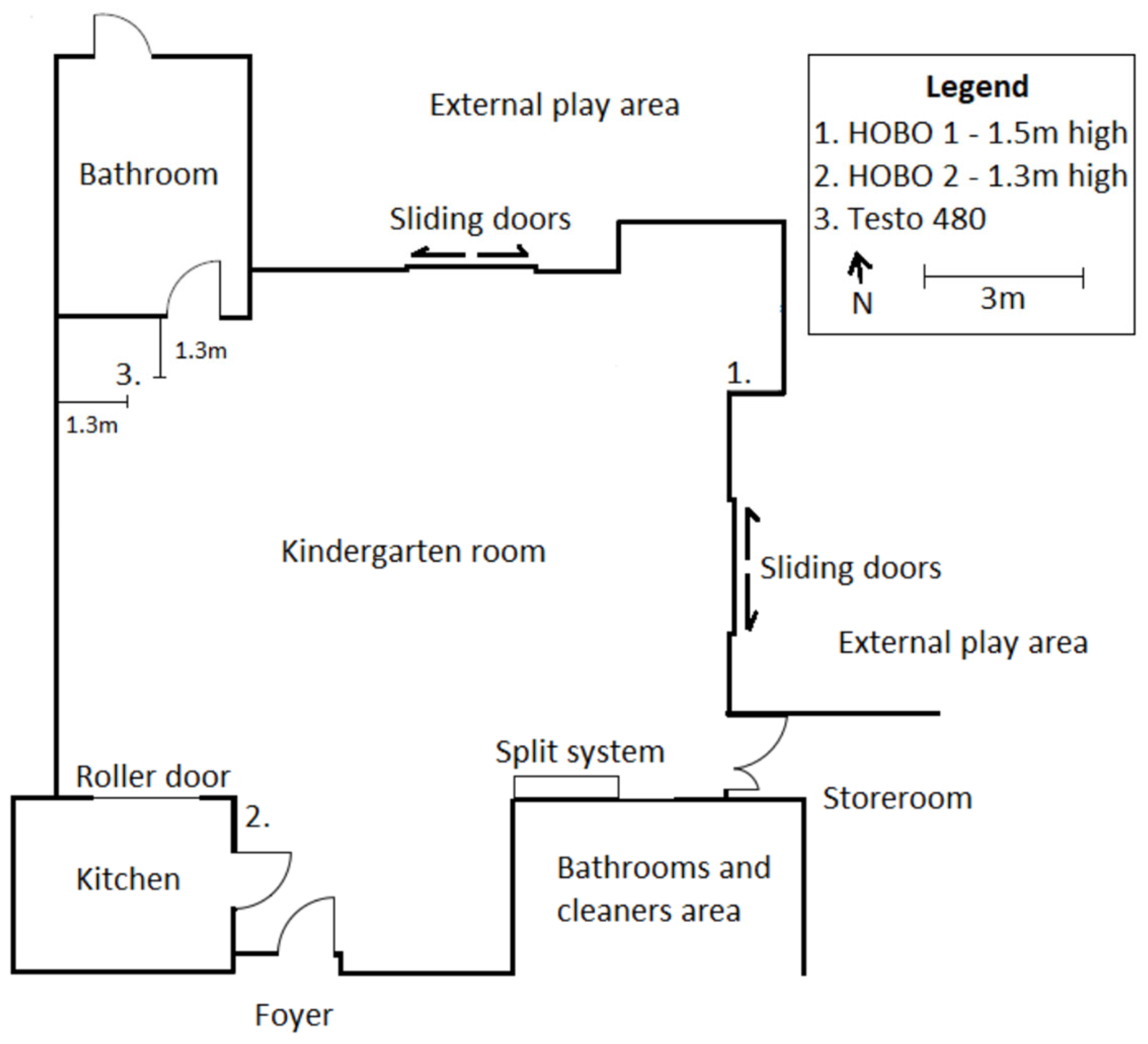
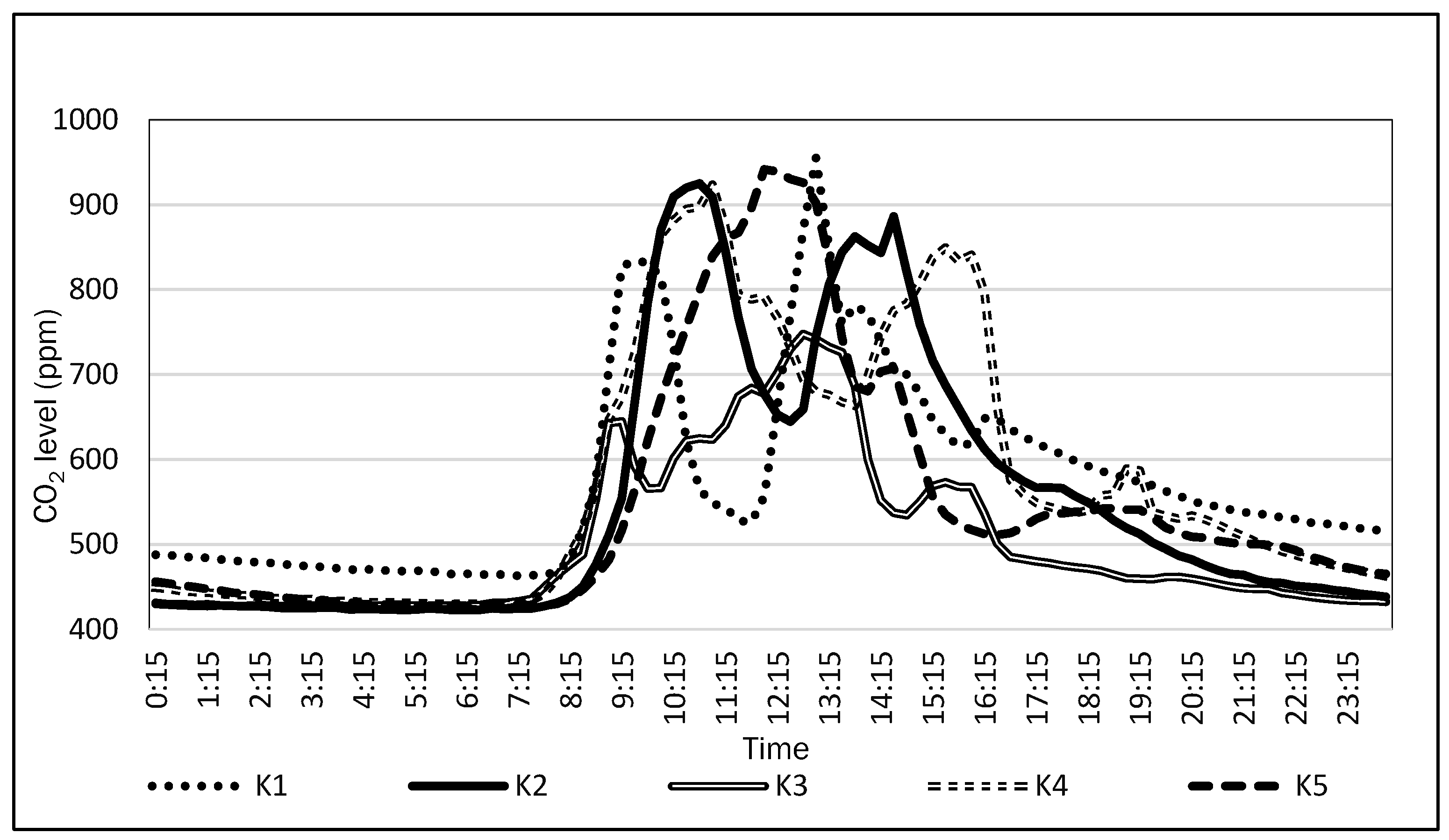
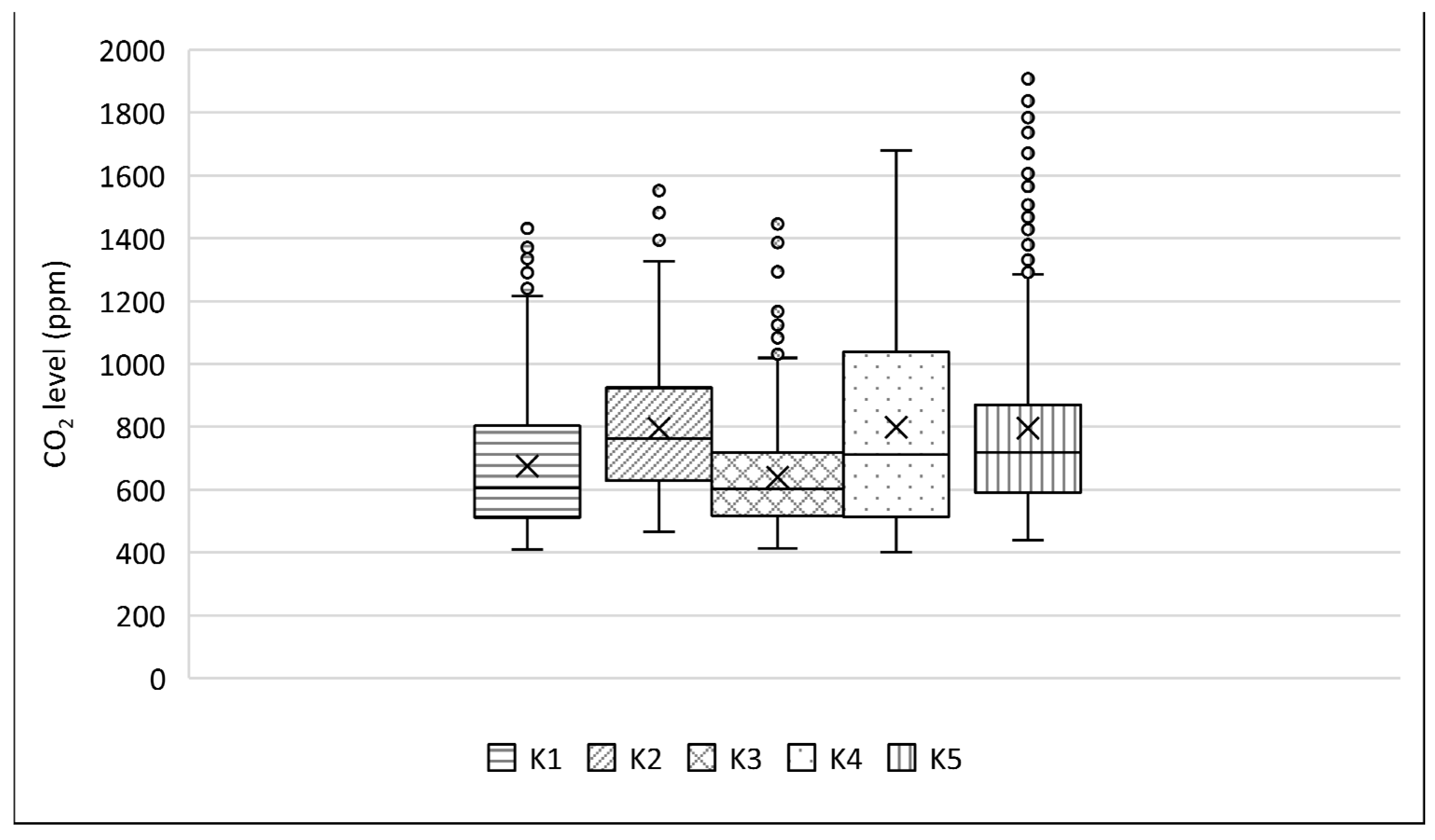

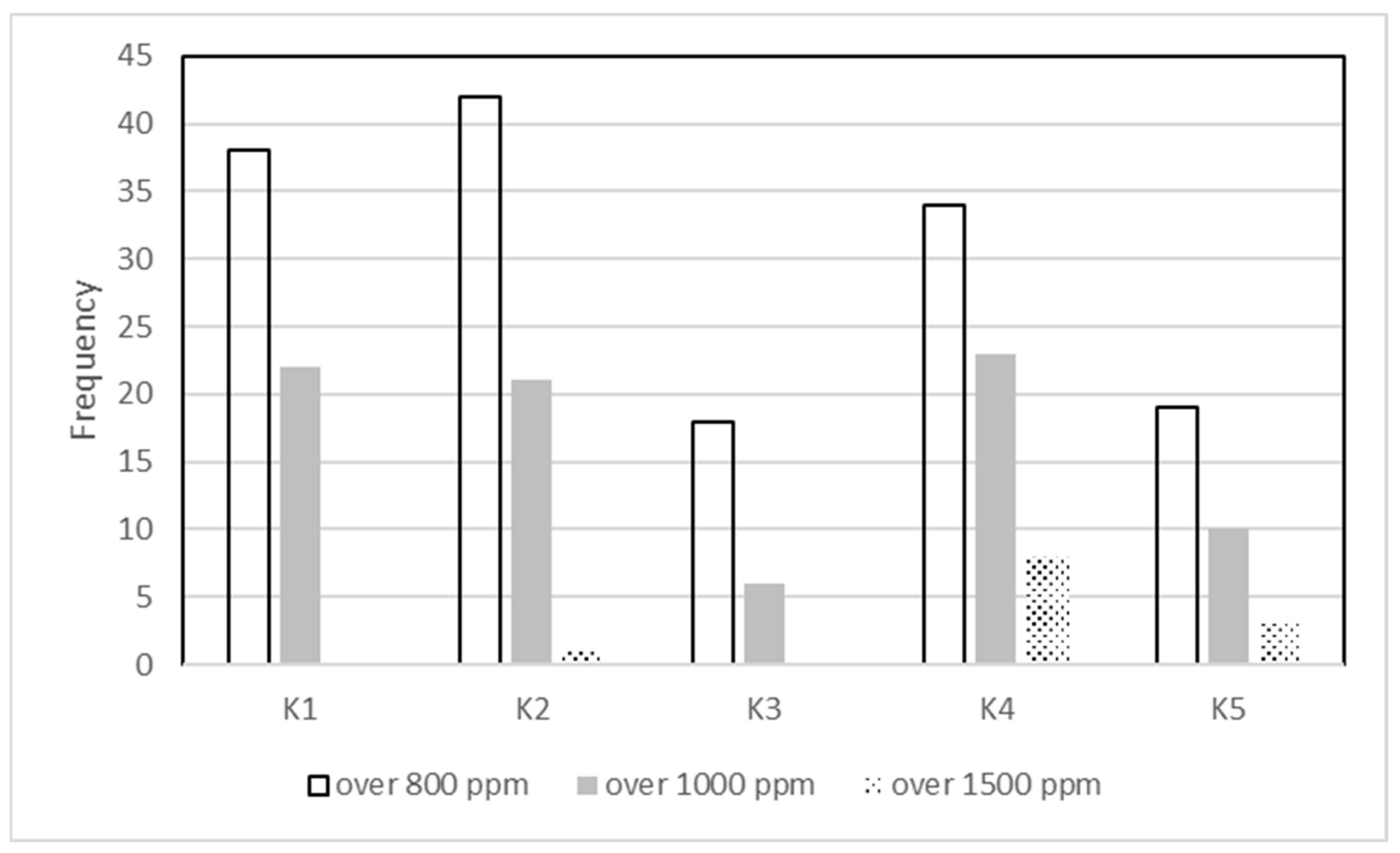
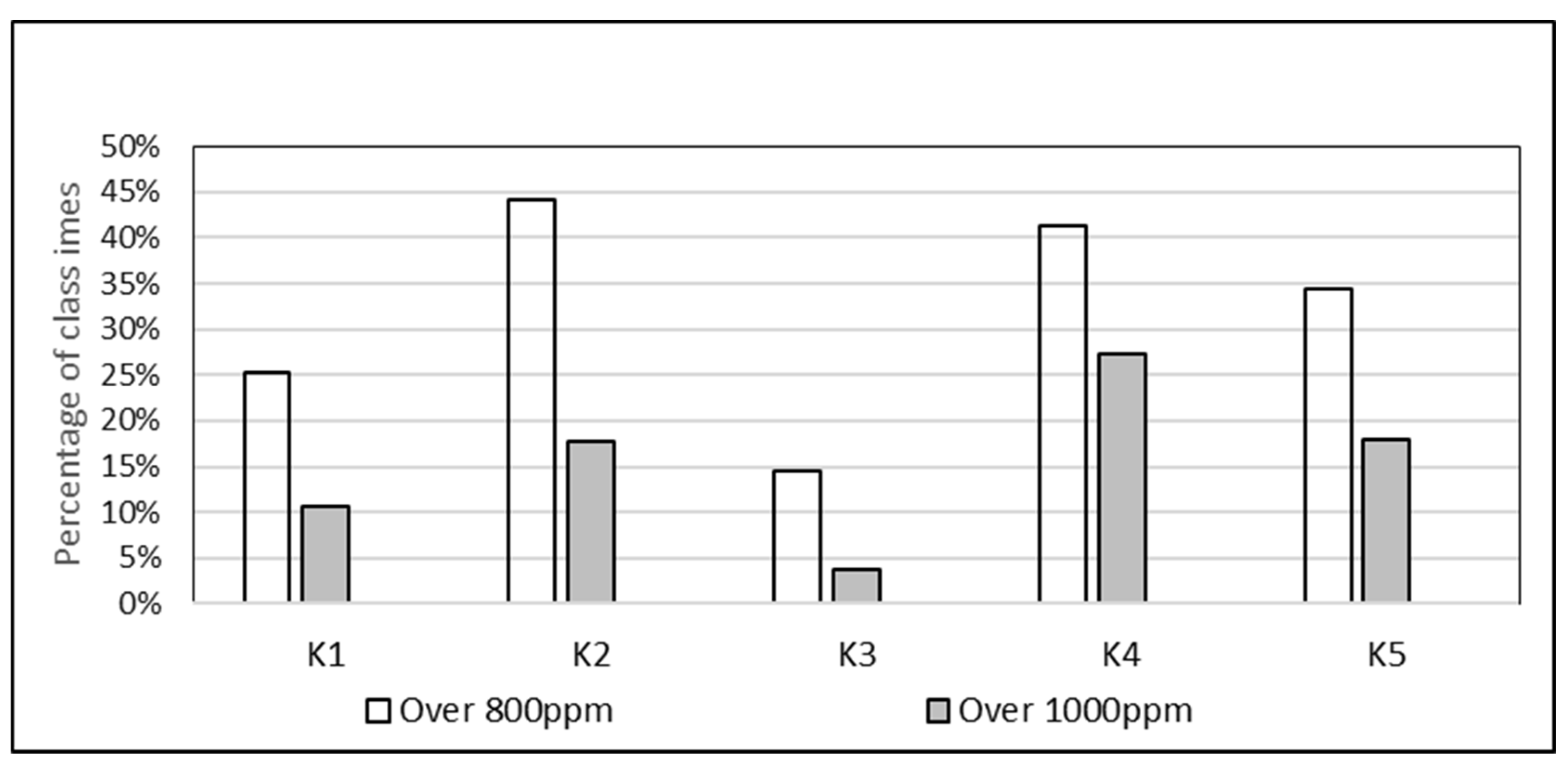

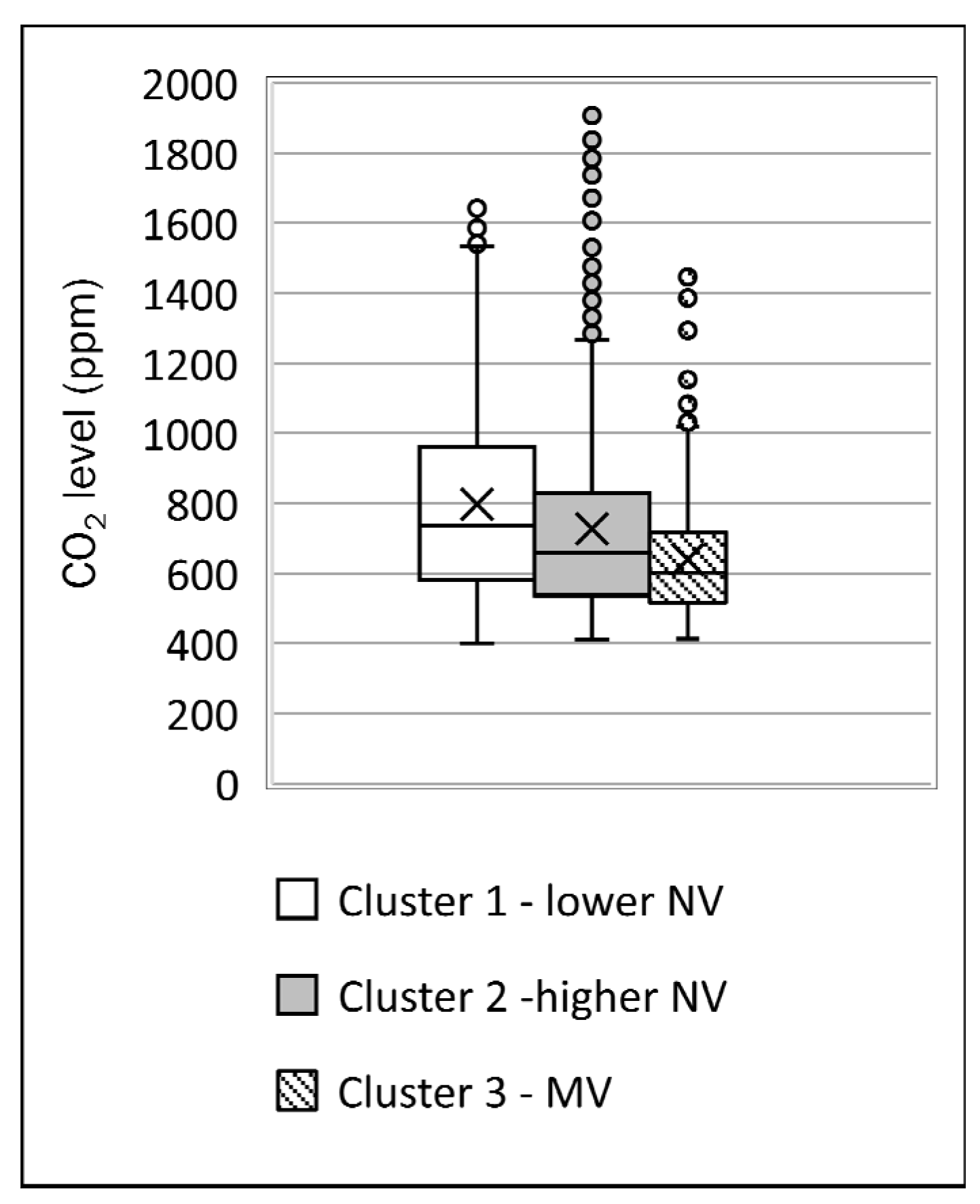

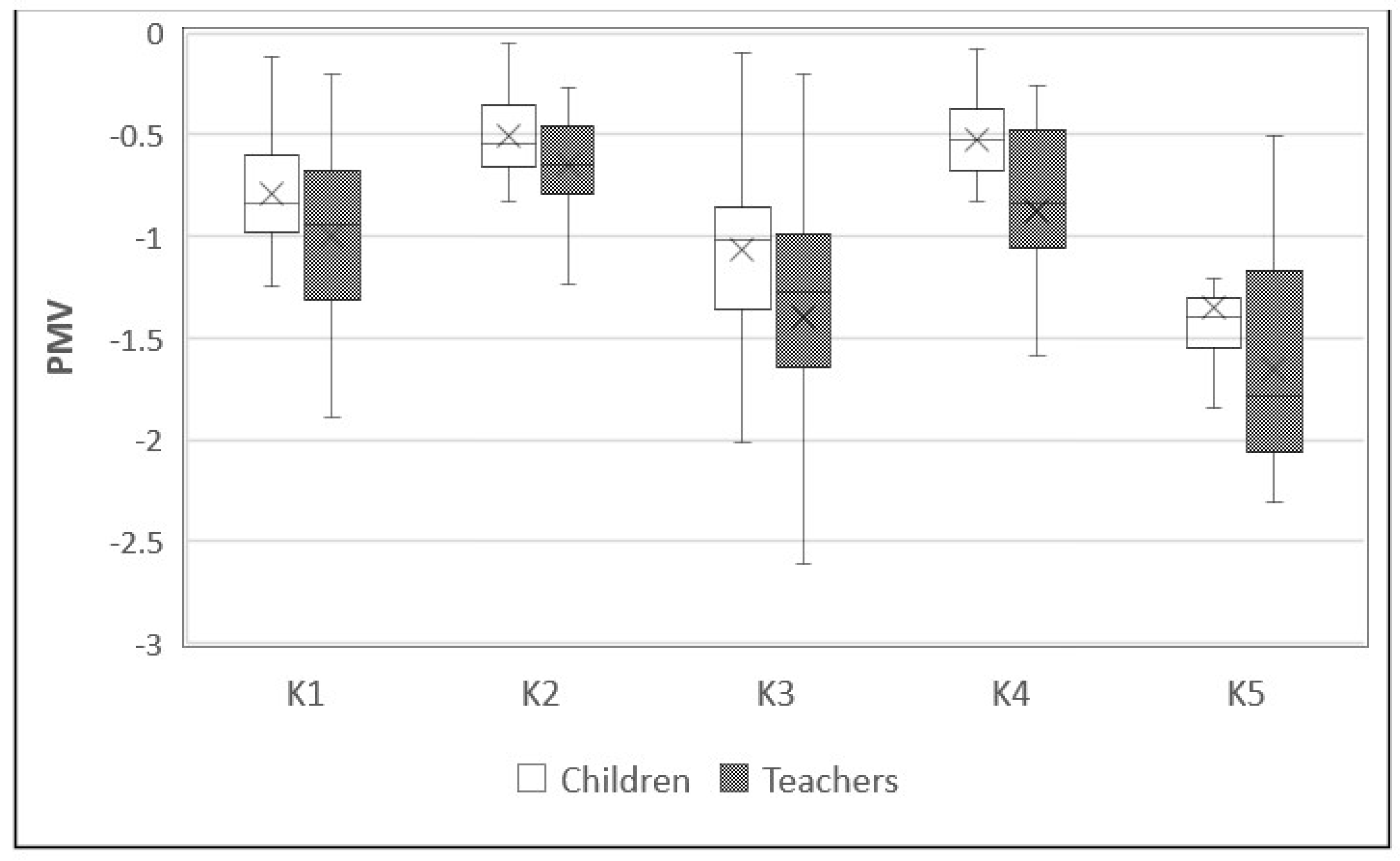
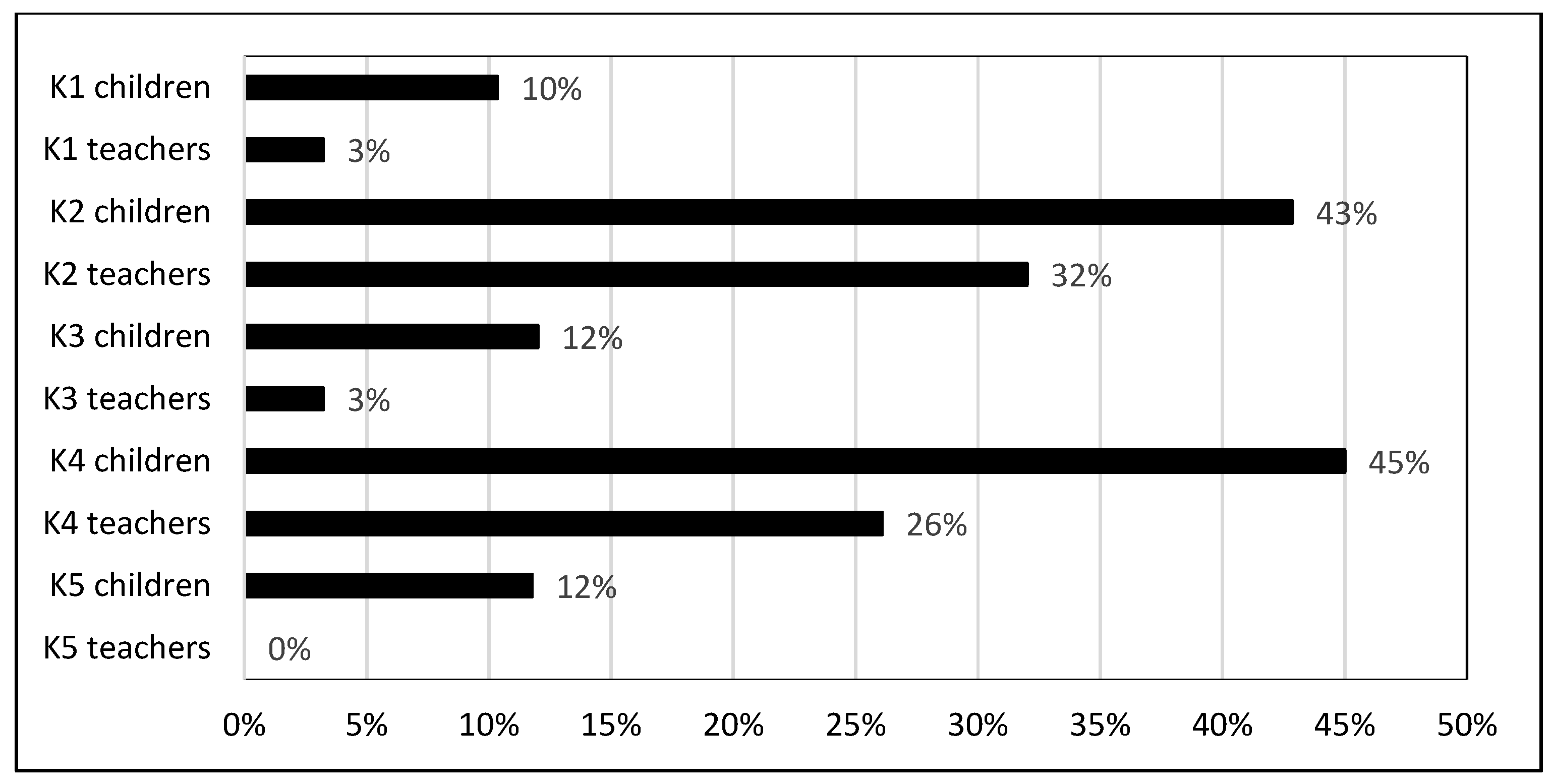
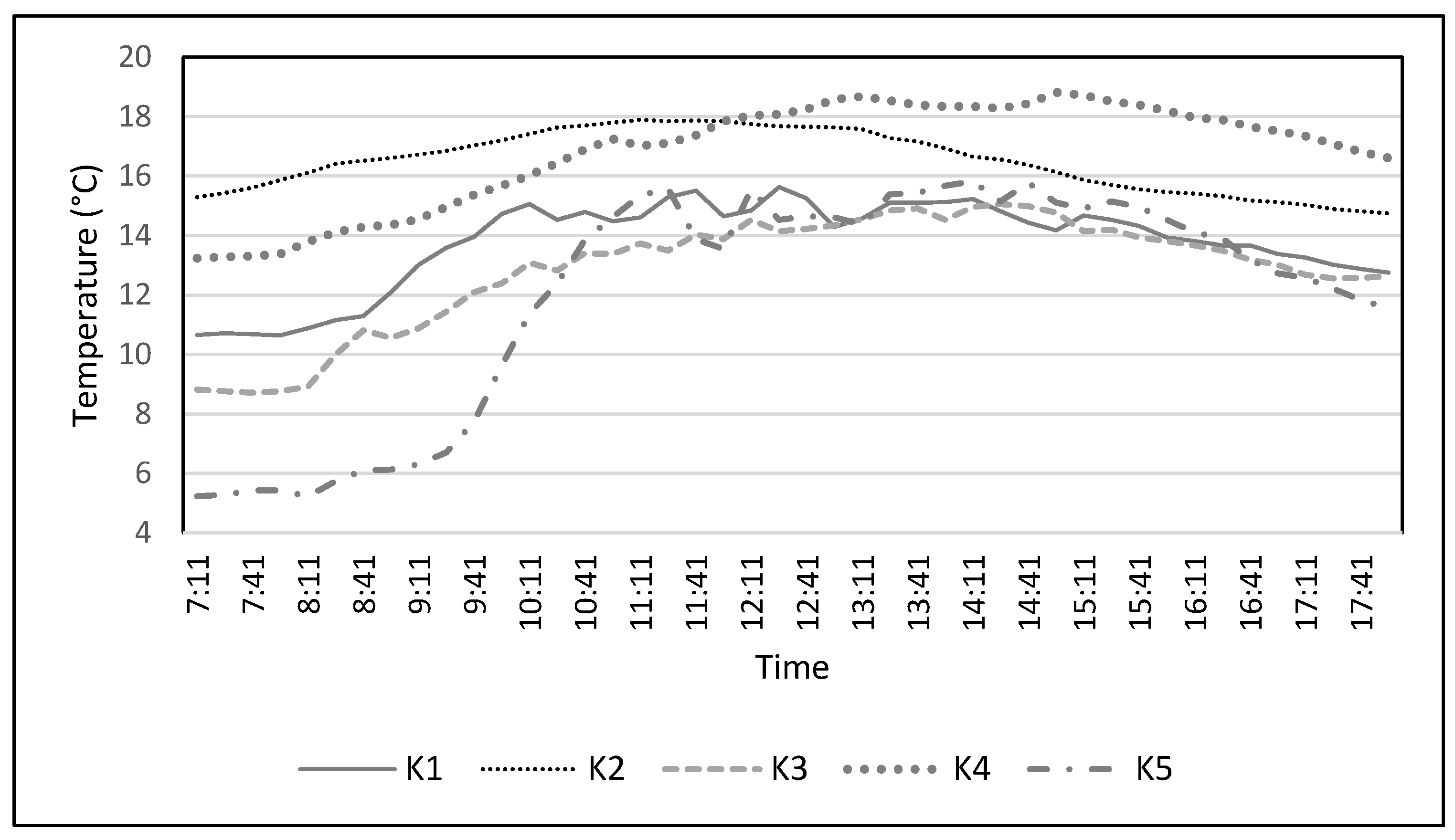
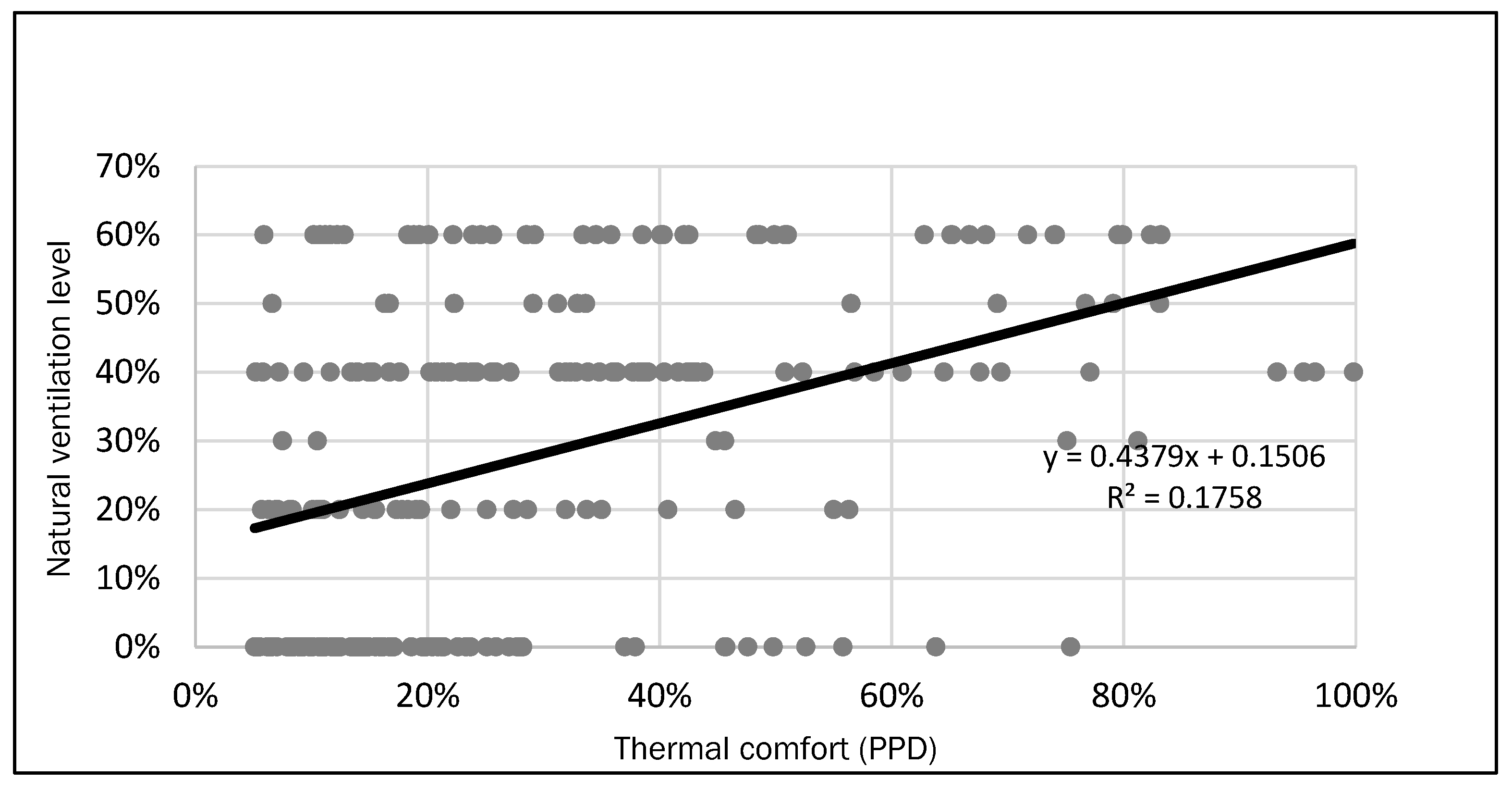
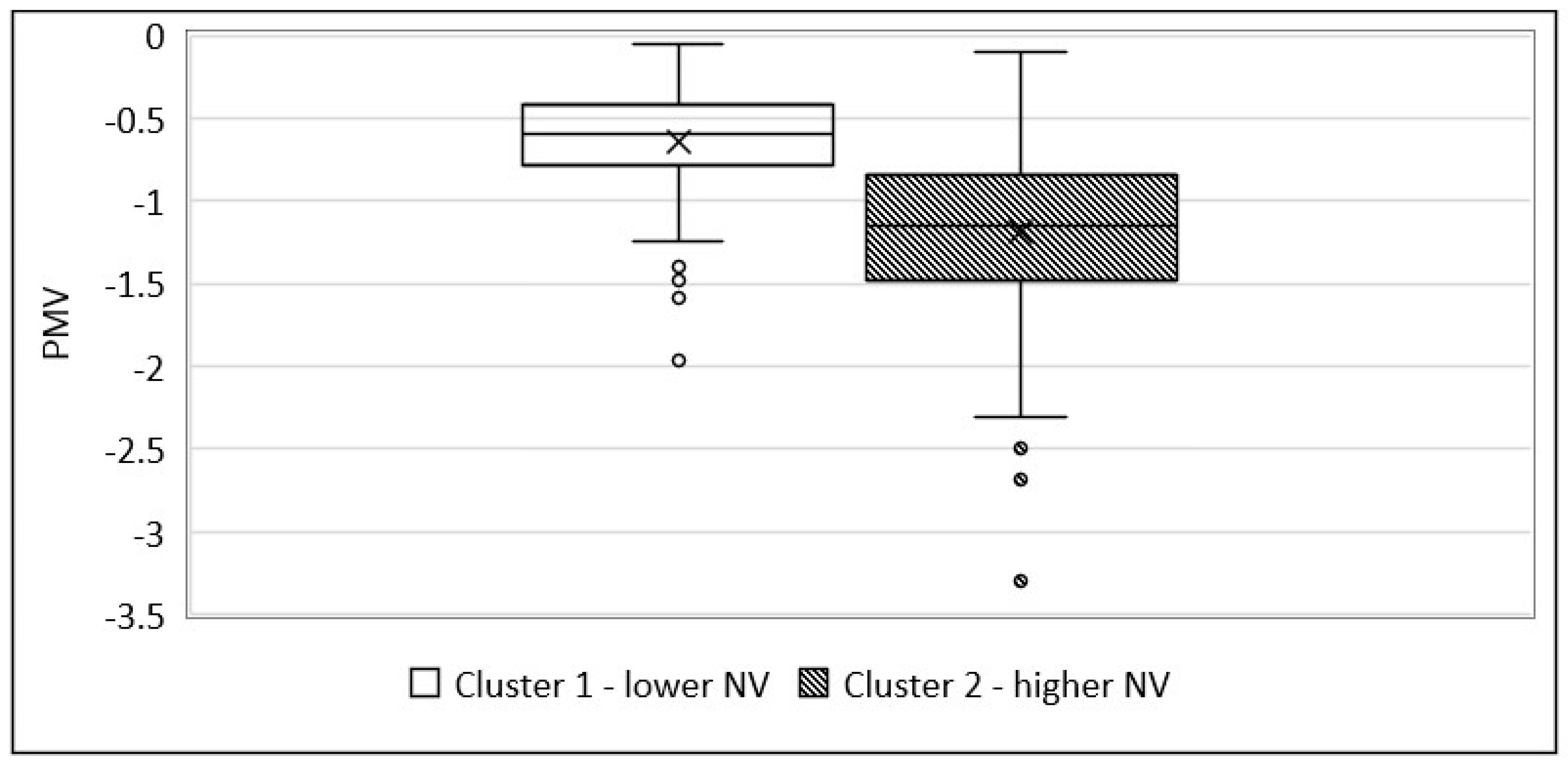
| Kindergarten/Main Monitoring Day | Building Age | Predominant Materials | Ventilation Design | Approximate Room Size | Approximate Room Volume | Approximate Elevation |
|---|---|---|---|---|---|---|
| K1 16 August 2022 | <10 years | Brick veneer wall, metal roof | Natural ventilation | 124 m2 | 347 m3 | 30–60 m |
| K2 29 August 2022 | 10–20 years | Cement sheet cladding and blocks, timber framing, plaster-lined walls—metal roof | Natural ventilation | 118 m2 | 429 m3 | 30–60 m |
| K3 1 August 2022 | 10–20 years | Cement sheet cladding and blocks, timber framing, plaster-lined walls, metal roof | Mechanical and natural ventilation | 115 m2 | 346 m3 | 30–60 m |
| K4 3 August 2022 | Over 50 years | Brick veneer—metal roof | Natural ventilation | 98 m2 | 268 m3 | 30–60 m |
| K5 8 August 2022 | Over 50 years | Brick veneer—metal roof | Natural ventilation | 148 m2 | 421 m3 | 300–400 m |
| Kindergarten | Peak CO2 Level Recorded | Average CO2 Level (Class Times) * | Average Peak CO2 Level (Class Days) ** | Ventilation Rates Peak (L/s) | Ventilation Rates Average (L/s) |
|---|---|---|---|---|---|
| K1 | 1432 ppm | 675 ppm | 955 ppm | 3.1 | 5.8 |
| K2 | 1552 ppm | 795 ppm | 925 ppm | 2.8 | 6.1 |
| K3 | 1446 ppm | 640 ppm | 748 ppm | 3.1 | 9.3 |
| K4 | 1679 ppm | 799 ppm | 923 ppm | 2.5 | 6.2 |
| K5 | 1908 ppm | 796 ppm | 942 ppm | 2.1 | 5.9 |
Disclaimer/Publisher’s Note: The statements, opinions and data contained in all publications are solely those of the individual author(s) and contributor(s) and not of MDPI and/or the editor(s). MDPI and/or the editor(s) disclaim responsibility for any injury to people or property resulting from any ideas, methods, instructions or products referred to in the content. |
© 2024 by the authors. Licensee MDPI, Basel, Switzerland. This article is an open access article distributed under the terms and conditions of the Creative Commons Attribution (CC BY) license (https://creativecommons.org/licenses/by/4.0/).
Share and Cite
Munckton, B.; Rajagopalan, P. Interaction between Thermal Conditions and Ventilation in Kindergartens in Melbourne, Australia. Sustainability 2024, 16, 1186. https://doi.org/10.3390/su16031186
Munckton B, Rajagopalan P. Interaction between Thermal Conditions and Ventilation in Kindergartens in Melbourne, Australia. Sustainability. 2024; 16(3):1186. https://doi.org/10.3390/su16031186
Chicago/Turabian StyleMunckton, Brett, and Priyadarsini Rajagopalan. 2024. "Interaction between Thermal Conditions and Ventilation in Kindergartens in Melbourne, Australia" Sustainability 16, no. 3: 1186. https://doi.org/10.3390/su16031186
APA StyleMunckton, B., & Rajagopalan, P. (2024). Interaction between Thermal Conditions and Ventilation in Kindergartens in Melbourne, Australia. Sustainability, 16(3), 1186. https://doi.org/10.3390/su16031186






